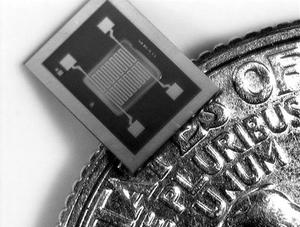DetectionNew detectors for chemical, biological threats
In the late 1990s, Sandia scientists developed a simple-to-use handheld chemical detector for the military, the MicroChemLab. Ever since, Sandia has improved such microfluidics- and microelectromechanical (MEMS) systems-based instruments that identify chemicals based on gas chromatography, or GC, and resonator-style instruments such as surface acoustic wave (SAW) detectors. The lab’s researchers are building on this sensor work to invent tiny detectors that can sniff out everything from explosives and biotoxins to smuggled humans.

Sandia-developed microdetectors offer ease of deployment // Source: sandia.gov
Sandia National Laboratories scientists are thinking small, building on decades of sensor work to invent tiny detectors that can sniff out everything from explosives and biotoxins to smuggled humans.
Their potential seems unlimited. The military needs to find low concentrations of chemicals, such as those used in roadside bombs or chemical warfare agents, before they hurt anyone, said researcher Ron Manginell. Soldiers often use detectors in less-than-ideal situations, looking for dangerous substances from among a rich miasma of diesel fumes, smoke and dust. They carry detectors into the field, where instruments must be portable, rugged, reliable and easy to use. In addition, inspectors at checkpoints and border crossings that see large numbers of containers lack automated ways to find trafficked people or contraband.
A Sandia Lab release reports that in the late 1990s, Sandia developed a simple-to-use handheld chemical detector for the military, the MicroChemLab. Ever since, Sandia has improved such microfluidics- and microelectromechanical (MEMS) systems-based instruments that identify chemicals based on gas chromatography, or GC, and resonator-style instruments such as surface acoustic wave (SAW) detectors.
Detection world needs new instruments
Manginell said SAW-based instruments will continue to be extremely important. The world of detection, however, also needs new instruments that can find compounds such as carbon dioxide, chemical signals unique to humans or the volatile signatures of pathogens and diseases in livestock and humans.
Manginell led a project to develop such a detector and couple it with GC. Together, they identify vapors by “sniffing” volatile organic compounds (VOCs). The prototype of the new detector, a miniature pulsed-discharge ionization detector, or mini-PDID, is about 1 inch by 1 inch by 2 inches, can be coupled with commercially produced micro-GCs and can run for nine hours on a charge of helium.
Experiments have shown the mini-PDID can detect explosives-related compounds, pesticides and toxic industrial compounds. “These are nasty things,” Manginell said. The detector also homes in on signatures of human odors and bacteria, light gases such as carbon monoxide and carbon dioxide and a broad range of organic compounds.
“We now have new detectors, like the PDID, with higher sensitivity and broader applicability that would integrate well with the SAW and micro-GCs to provide both sensitivity, the ability to detect a few molecules of a given compound, and selectivity, the ability to distinguish compounds from one another,” Manginell said. A miniaturized vapor detection unit and subsidiary electronics could fit in a format no larger than a cell
